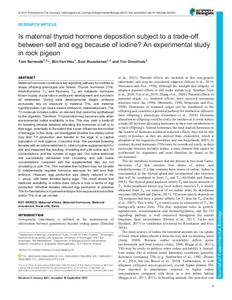Is maternal thyroid hormone deposition subject to a trade-off between self and egg because of iodine? An experimental study in rock pigeon
Sarraude Tom; Hsu Bin-Yan; Ruuskanen Suvi; Groothuis Ton
Is maternal thyroid hormone deposition subject to a trade-off between self and egg because of iodine? An experimental study in rock pigeon
Sarraude Tom
Hsu Bin-Yan
Ruuskanen Suvi
Groothuis Ton
COMPANY BIOLOGISTS LTD
Julkaisun pysyvä osoite on:
https://urn.fi/URN:NBN:fi-fe2021120859694
https://urn.fi/URN:NBN:fi-fe2021120859694
Tiivistelmä
Maternal hormones constitute a key signalling pathway for mothers to shape offspring phenotype and fitness. Thyroid hormones (THs; triiodothyronine, T-3; and thyroxine, T-4) are metabolic hormones known to play crucial roles in embryonic development and survival in all vertebrates. During early developmental stages, embryos exclusively rely on exposure to maternal THs, and maternal hypothyroidism can cause severe embryonic maldevelopment. The TH molecule includes iodine, an element that cannot be synthesised by the organism. Therefore, TH production may become costly when environmental iodine availability is low. This may yield a trade-off for breeding females between allocating the hormones to self or to their eggs, potentially to the extent that it even influences the number of laid eggs. In this study, we investigated whether low dietary iodine may limit TH production and transfer to the eggs in a captive population of rock pigeons (Columba livia). We provided breeding females with an iodine-restricted (I-) diet or iodine-supplemented (1+) diet and measured the resulting circulating and yolk iodine and TH concentrations and the number of eggs laid. Our iodine-restricted diet successfully decreased both circulating and yolk iodine concentrations compared with the supplemented diet, but not circulating or yolk THs. This indicates that mothers may not be able to independently regulate hormone exposure for self and their embryos. However, egg production was clearly reduced in the I- group, with fewer females laying eggs. This result shows that restricted availability of iodine does induce a cost in terms of egg production. Whether females reduced egg production to preserve THs for themselves or to prevent embryos from exposure to low iodine and/or THs is as yet unclear.
Kokoelmat
- Rinnakkaistallenteet [27094]
